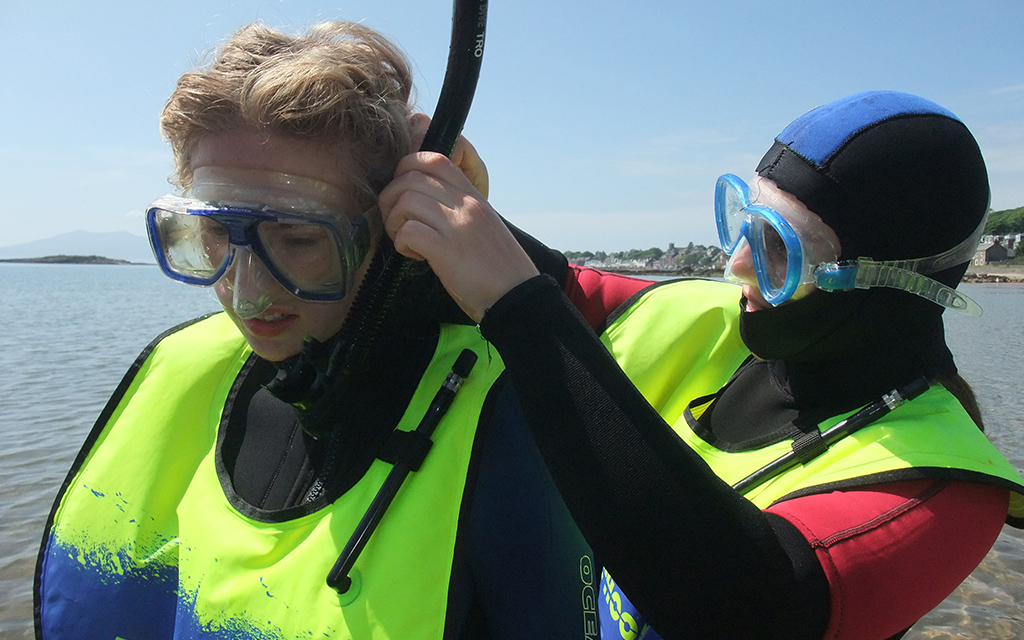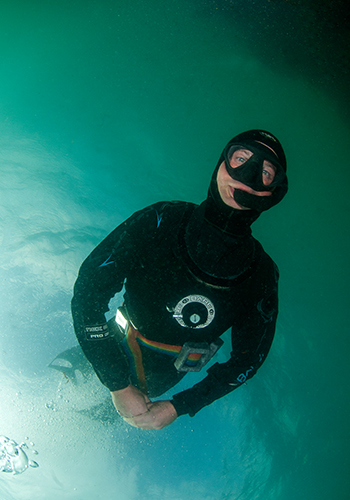
Andy Torbet discusses snorkelling hazards, their prevention, avoidance and how to get out of trouble.
Snorkelling is one of the most straightforward ways of experiencing the underwater world. However, we can’t pretend there aren’t some potential hazards to consider. But then these problems, if identified and addressed, can be easily negated to ensure an enjoyable and trouble-free outing.
Current and waves
We need to be aware of strong currents which may pull us down or away from safety. Waves can pose a problem making entry and exit dangerous, especially if the swell has increased since we got in. This is an important aspect of a snorkel leader’s risk assessment.
Boats
We snorkellers spend most of our time on the surface, where we are obviously exposed to boat traffic. Ideally we’d all be wearing bright orange wetsuits but these can be hard to find and, frankly, black is cooler. We can choose sites with little or no boat traffic, carry permanent surface marker buoys (which also act as a safety floats, should we get tired) and ensure we regularly look up and cast a 360-degree glance around to check for shipping. When I’ve had to swim in an area of high boat traffic I also find it useful to stick close to objects boats find hazardous such as rocks, exposed shipwrecks or under piers.
Fishing line
This is one of my biggest concerns when snorkelling. The UK, as an island nation, has a great deal of commercial and recreational fishing. So discarded lines and nets are not an unusual sight around our shores. Entanglement is always hazardous but is especially so when you do not have breathing apparatus.
You can prevent problems by avoiding beaches popular with anglers and being aware of the dangers around wrecks, a capture point for lost nets. I recommend every snorkeller carries some sort of line-cutting tool to free themselves in the event of entanglement. Equally important is a snorkel buddy, as it is always easier to get out of entanglement with the help of another. That said, you should take care the rescuer does not also become entangled.

Over-weighted
A bit of additional weight can make duck-diving and remaining neutral at depth easier. But it can cause dangerous problems on the surface when you have to fight to keep your head above water to breathe. Make sure you are correctly weighted for the thickness of wetsuit you’re wearing or, if you don’t plan on duck diving, wear no weight at all. Always err on the side of caution.
Cold
Folk get cold while diving around Britain? I’m afraid it’s true! Being well-rested and well-fed makes a huge difference, as does moving around. You’d be surprised the difference a constant, gently swimming pace makes to your body temperature. Wear a suit appropriate to the water temperature, but also how long you’ll be in. Off Cornwall, in the summer it can be 18°C so I’ll dive in a 5mm or 7mm suit depending on how long I’ll be in. Also be aware of thermoclines, where the water temperature drops suddenly due to a change in depth. They can be shallow, especially in lakes, where a short duck dive can put you in much colder water.
Tiredness
Snorkelling, especially in energy-sapping colder waters and in bulky wetsuits, can be tiring. Be aware of your fitness and energy levels and plan accordingly. Planning to swim a mile offshore, after a long night travelling and lack of sleep might not be the best plan. Especially when it means another mile’s swim to get back home. Constantly evaluate this factor.
Seasickness
Most snorkelling is conducted from shore so this may seem an insignificant problem. However, we spend most of a dive on the surface and are therefore more exposed to the movement of the waves and swell. I’d not recommend anything as severe as medication, but if you start feeling queasy in choppy waters I’m afraid the only real cure is to head for shore and sit under a tree.
Sunburn
If you take to the seas, at home or abroad, in just shorts or a bikini, be aware your back is exposed to the full force of the sun. Between snorkels, the sun is warming you up, but it is still a danger so cover up and use sun cream (opt for marine-friendly sunscreen wherever possible) on exposed skin, but remember to wash it off before donning a mask when you return to the water.
Cramp
There can’t be many divers or snorkellers who haven’t experienced cramp at some point. It’s unpleasant, but seldom life-threatening. However, if it comes when you’re trying to fight current or have a long swim back to shore, it can be more dangerous. Plenty of fluids, warming up, stay warm and even a bit pre-snorkel.
Snorkel with your local BSAC club!
Not yet a BSAC member? Let us help you find your local BSAC club
Send your postcode to hello@bsac.com and we'll help you find the right scuba club for you. Or if you fancy a chat call us 0151 350 6226 (Mon - Fri, 9 - 5:30).
For more information on snorkelling with BSAC go to bsac.com/snorkelling. Looking to introduce snorkelling into your club? Find out more at bsac.com/snorkellinginstructor.
If any of you have any suggestions, I’d love to hear them. Drop a note to me through the editor’s email at SCUBA or on my social media below:
Facebook: OfficialAndyTorbet
Instagram: @andy_torbet
Twitter: @andytorbet
Article by Andy Torbet for SCUBA magazine, Issue 93 August 2019.
Images in this online version have been substituted from the original images in SCUBA magazine due to usage rights. Featured image by xxxx.
Find out more about learning to snorkel or discover snorkelling in the UK.

 Author: Andy Torbet | Posted 14 Sep 2019
Author: Andy Torbet | Posted 14 Sep 2019


